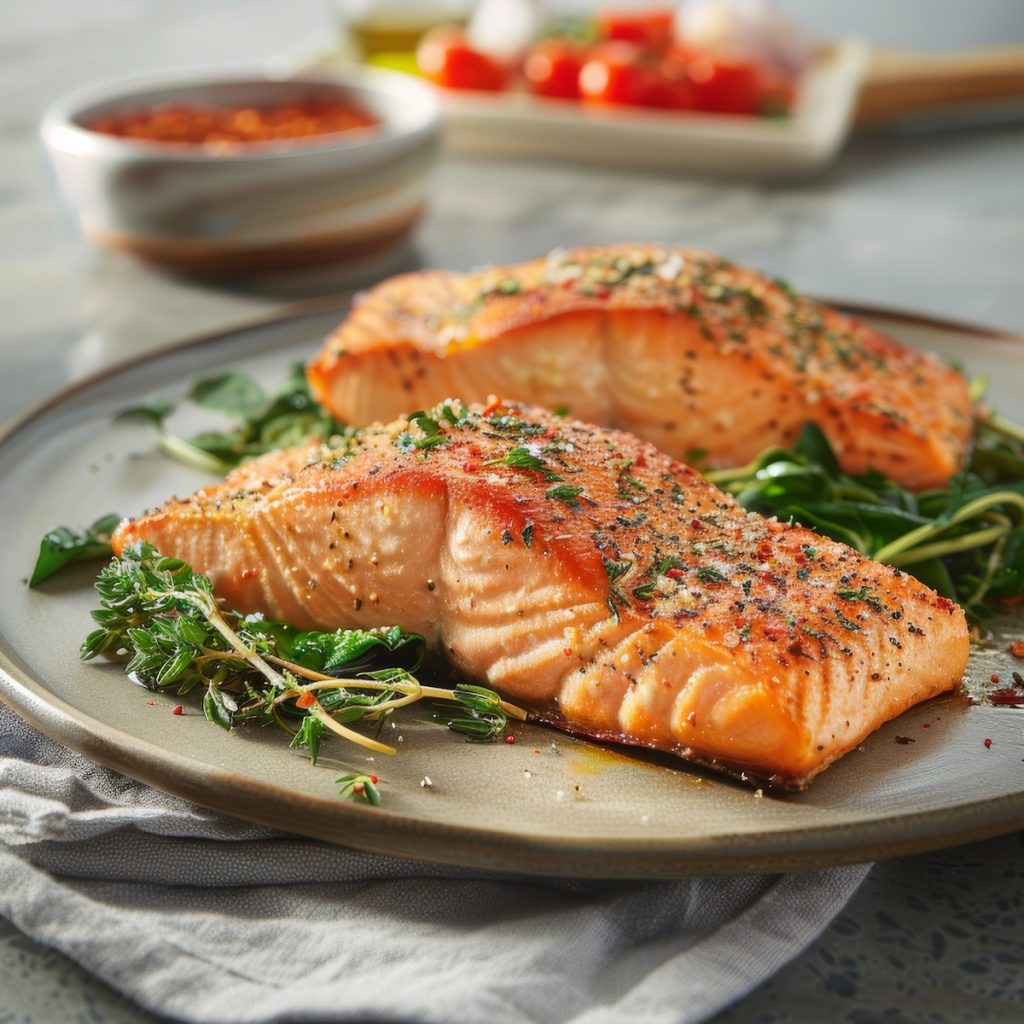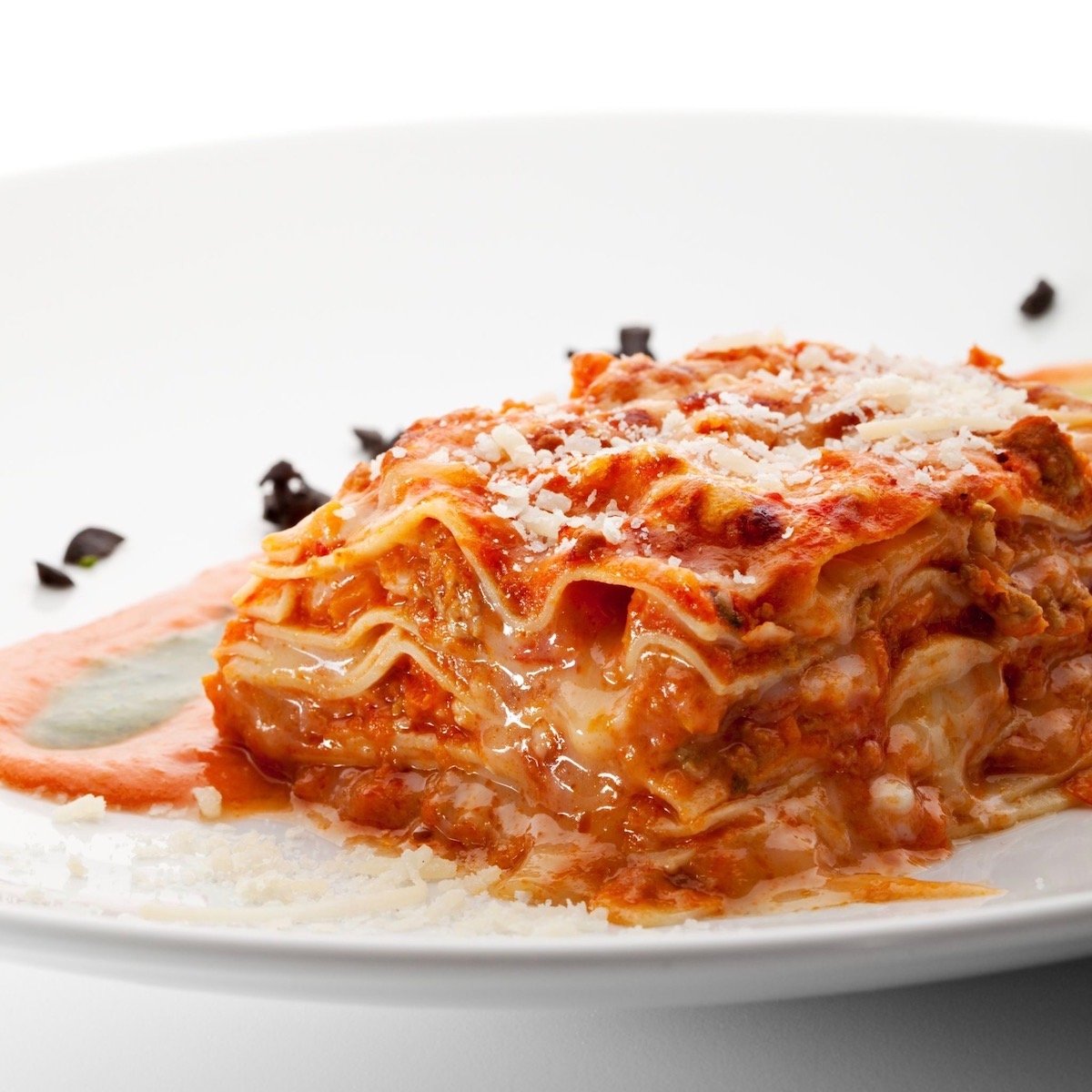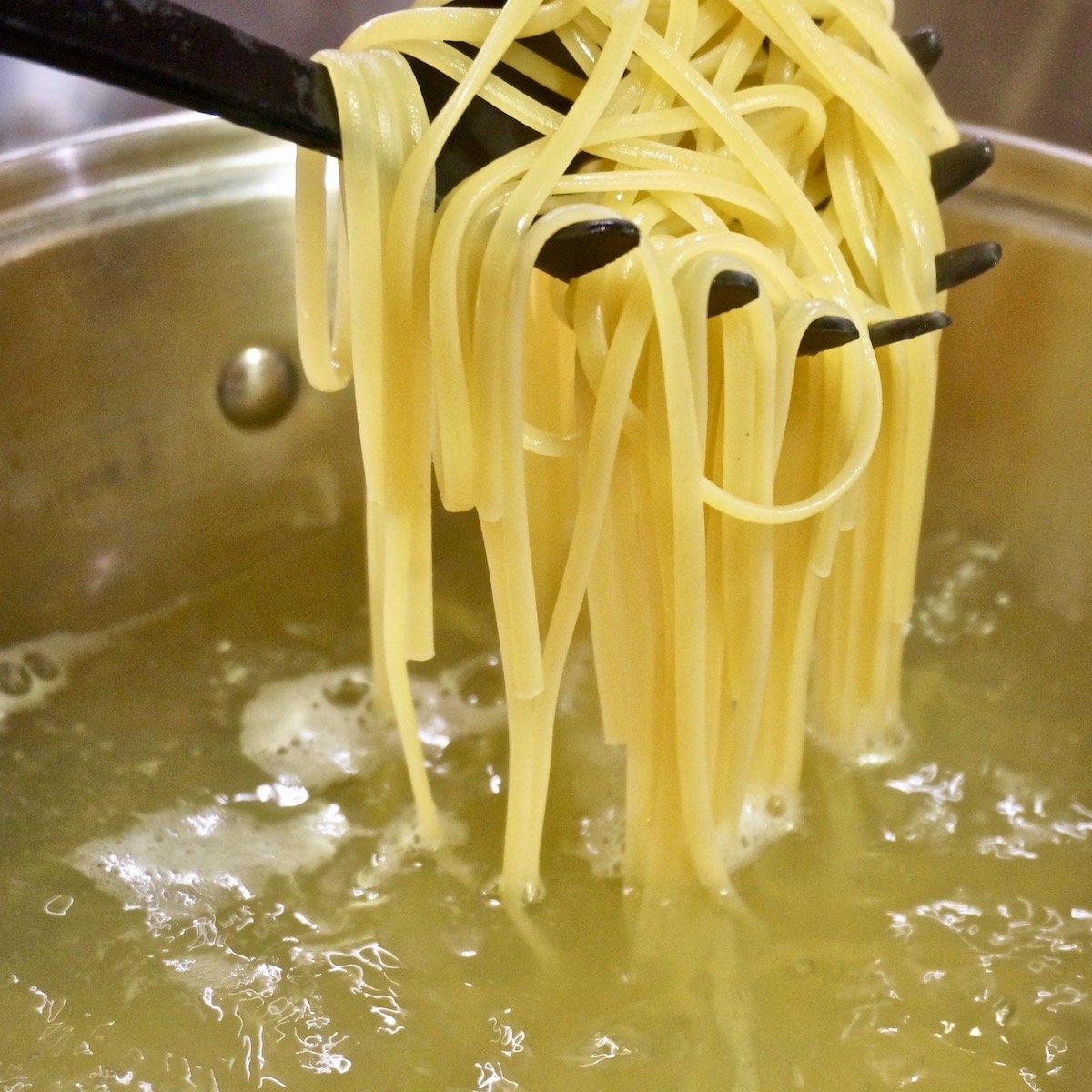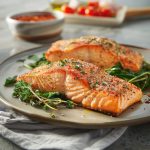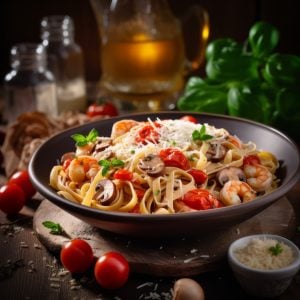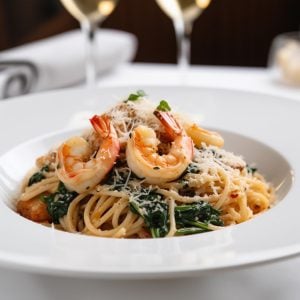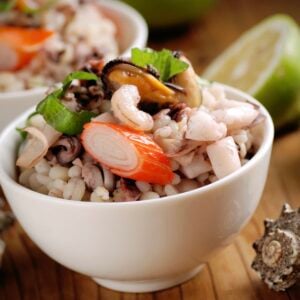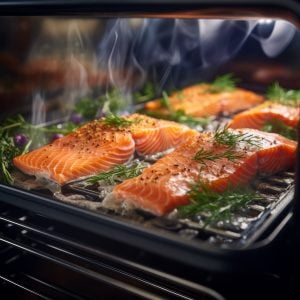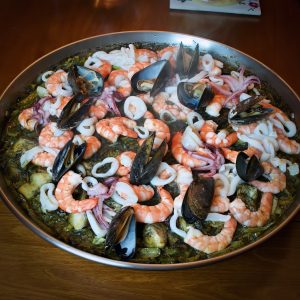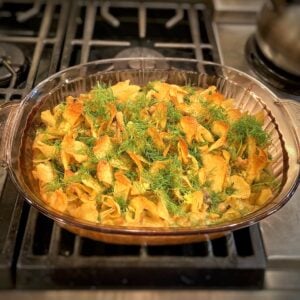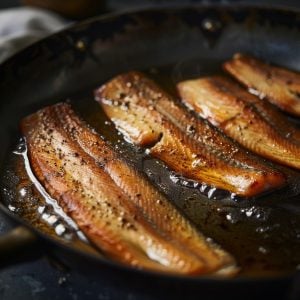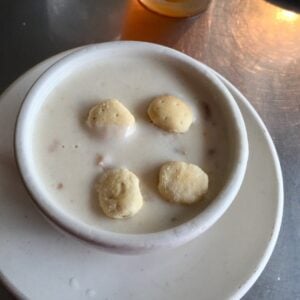Baked and Slow-Baked Salmon
Baking salmon is one of the easiest techniques to learn and produces great outcomes. We will also examine a technique called slow-baking salmon in this post. Both offer great results; one takes a little longer, and I’ll discuss the pros and cons of each.
Baked Salmon
Baking salmon is a simple cooking technique that involves cooking the fish in the oven. Here are the basic steps involved in baking salmon:
- Preheat the oven to the desired temperature. A temperature of 400°F (200°C) is common for baking salmon, but you can adjust the temperature based on your recipe.
- Season the salmon fillets with salt, pepper, or other seasonings. You can also brush the fillets with olive oil or melted butter to help prevent them from sticking to the baking dish.
- If the skin is still on, place the salmon fillets in a baking dish, skin-side down. You can use a glass or ceramic baking dish, a metal baking sheet, or a roasting pan.
- Bake the salmon in the preheated oven for 12-15 minutes or until the flesh is opaque and flakes easily with a fork. The cooking time may vary depending on the thickness of the fillets and the desired level of doneness.
- Remove the salmon from the oven and let it rest for a few minutes before serving. If desired, garnish the salmon with fresh herbs or lemon wedges.
Baking salmon is a simple and healthy way to prepare this delicious fish. Before baking, you can customize the recipe by adding different seasonings or sauces to the fish.
Prepping Salmon for Baking
Here are the steps to prep salmon for baking:
- Preheat your oven to the desired temperature. Typically, a temperature of 400°F (200°C) is recommended for baking salmon.
- Rinse the salmon fillets under cold water and pat them dry with paper towels.
- If the salmon has skin on, leave it on for baking. This helps to keep the flesh moist during cooking. However, you can also remove the skin before baking if you prefer.
- Season the salmon fillets with salt and pepper and any other seasonings you prefer, such as garlic, herbs, or spices.
- Optional: Add a marinade or sauce to the salmon before baking. Some popular marinades for salmon include honey mustard, soy sauce, and ginger, or lemon and herb.
By following these simple steps, you can easily prepare delicious, flavorful, moist, and tender baked salmon.
Baked Salmon
Ingredients
- 4 filets salmon about 6 ounces each
- salt and pepper to taste
- olive oil or cooking spray
- lemon wedges optional
Instructions
- Preheat the oven to 400°F (200°C). Line a baking sheet with parchment paper or aluminum foil.
- Pat the salmon fillets dry with paper towels and season both sides with salt and pepper.
- Place the salmon fillets on the prepared baking sheet, skin-side down. If the skin has been removed, brush the flesh with olive oil or cooking spray.
- Bake the salmon in the preheated oven for 12-15 minutes or until the flesh is opaque and flakes easily with a fork.
- Remove the salmon from the oven and let it rest for a few minutes before serving. Squeeze lemon wedges over the top, if desired.
Notes
What’s the difference between baked salmon and roasted salmon?
Baked and roasted salmon are the same cooking method and are often used interchangeably in recipes. Both methods involve cooking the salmon in an oven, and the temperature and cooking time may be similar.
However, some people differentiate between the two methods based on the type of baking dish used. Baked salmon may be cooked in a glass or ceramic baking dish, while roasted salmon is typically cooked on a sheet or roasting pan.
Additionally, roasted salmon may be cooked at a slightly higher temperature than baked salmon, which can result in a slightly crispier exterior. However, this difference is generally minimal and can be achieved by adjusting the temperature and cooking time. Ultimately, the difference between baked salmon and roasted salmon is largely a matter of semantics and personal preference.
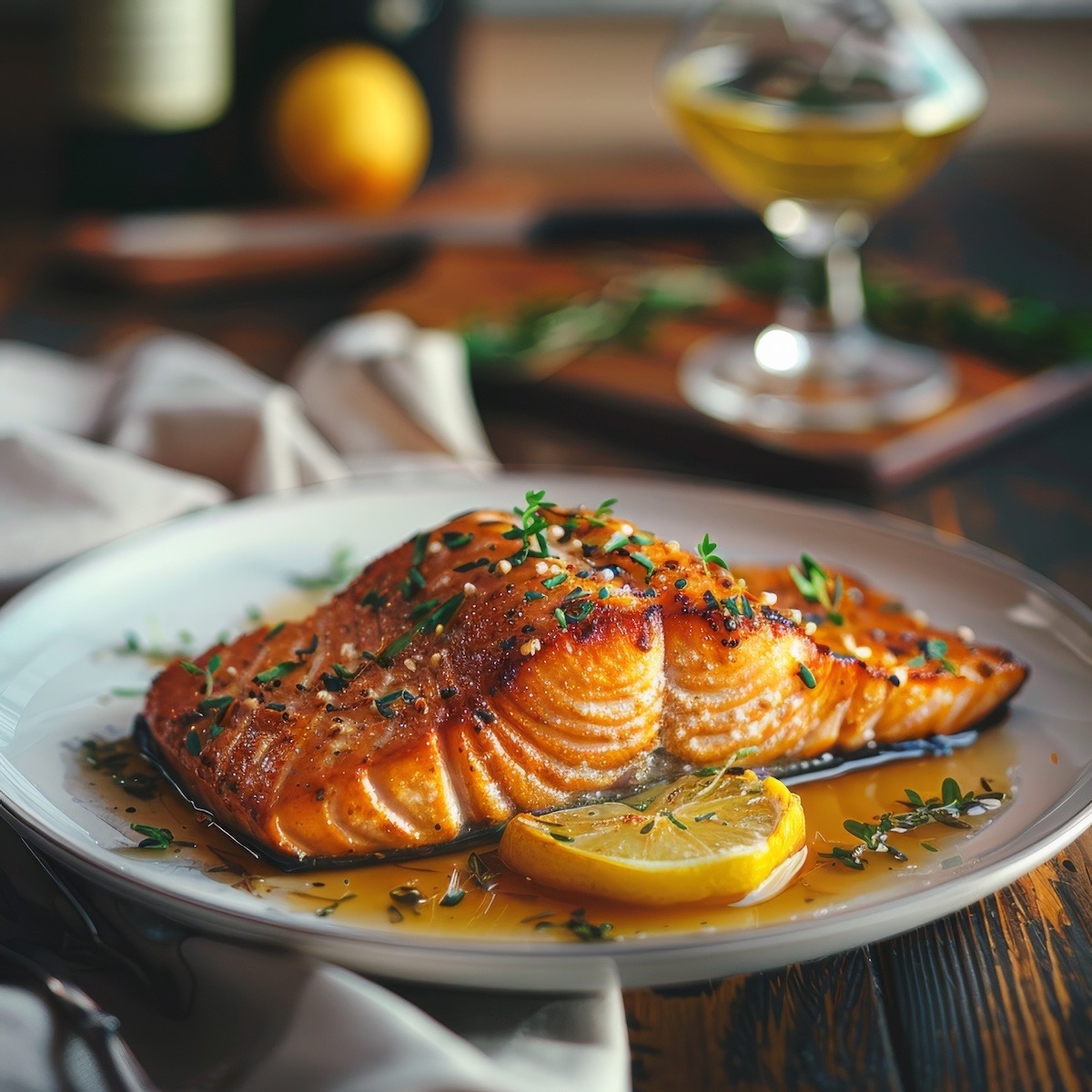
Slow Baked Salmon
This is a cooking method where the salmon is cooked at a low temperature for a longer period of time, usually around 250°F (120°C) for 30-40 minutes. This method results in a tender, moist, and flaky salmon cooked evenly without overcooking or drying out. There are several advantages of slow-baking salmon:
- Even cooking: Ensures the fish is cooked evenly, without any dry or overcooked spots. The low temperature allows the heat to penetrate the salmon slowly and evenly.
- Moisture retention: Low heat helps retain moisture in the fish, resulting in a juicy and tender texture. The low heat prevents the fish from drying out, which can often happen with higher-heat cooking methods like grilling or broiling.
- Flavor infusion allows the flavors of herbs, spices, or other ingredients to infuse into the fish more deeply, resulting in a more flavorful dish.
- Ease of preparation: This is a relatively hands-off cooking method, which makes it easy to prepare. Season the salmon, place it in a baking dish, and let it bake in the oven until it’s done.
This is an excellent option for those who want tender, juicy, and flavorful fish that is easy to prepare. It is also a healthier option, as it doesn’t require as much oil or fat as other cooking methods, such as frying or sautéing.
How Is It Different from Baking Salmon?
Slow-baked salmon is a specific baking method, but the key difference is the temperature and time used for cooking. Regular baked salmon is typically cooked at a higher temperature, around 350-400°F (175-200°C), for a shorter period, usually around 12-15 minutes per inch of thickness.
In contrast, slow-baked salmon is cooked at a lower temperature, around 250°F (120°C), for a longer period of time, usually around 30-40 minutes. This low-temperature cooking method allows the salmon to cook slowly and evenly, resulting in a tender, moist, and flaky texture.
The slower cooking time also allows for the flavors of any herbs, spices, or other ingredients to infuse more deeply into the fish. This is a great option for those who want a more tender, flavorful, and foolproof way of cooking salmon. However, it does take longer to cook than regular baked salmon, so it may not be the best option if you’re short on time.
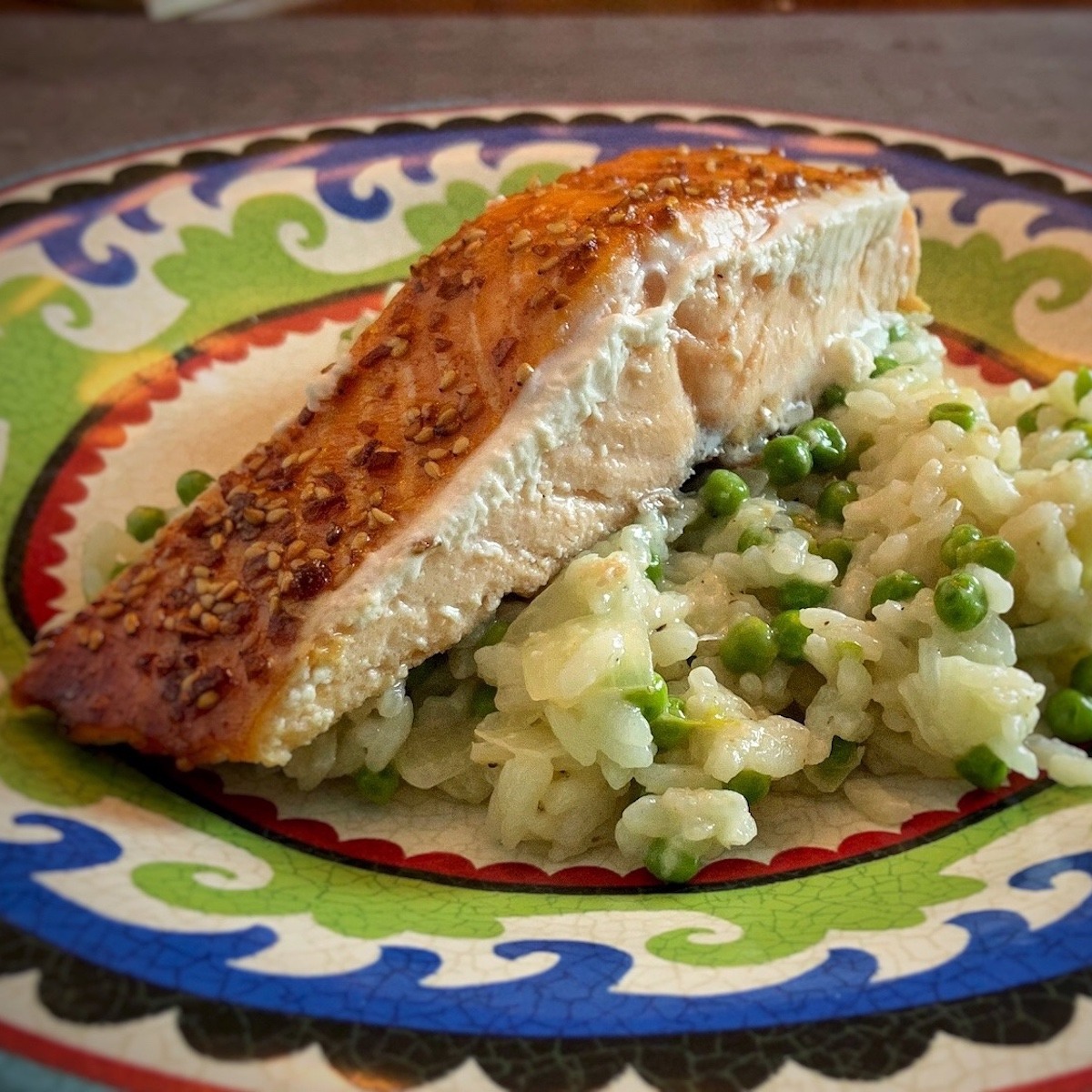
Pros and Cons
Pros:
- Tender, moist, and flaky texture: Slow-baking salmon at a low temperature for a longer period of time results in a tender, moist, and flaky texture that melts in your mouth.
- Evenly cooked: The low temperature and longer cooking time help to cook the salmon evenly without any dry or overcooked spots.
- Flavorful: The slow cooking allows the flavors of herbs, spices, or other ingredients to infuse more deeply into the fish, resulting in a more flavorful dish.
- Healthier: Slow-baking salmon is a healthier option than other cooking methods like frying or sautéing as it requires less oil or fat.
Cons:
- Longer cooking time: Slow-baking salmon takes longer than other cooking methods, so it may not be the best option if you’re short on time.
- Less crispy skin: Slow-baking salmon may produce less crispy skin than other cooking methods like grilling or broiling.
- Not suitable for all types of salmon: Slow-baking salmon is best suited for thicker fillets or whole fish and may not work as well for thinner or smaller cuts of salmon.
Slow-baking salmon is a great option for those who want a tender, flavorful, and healthier way of cooking salmon. However, it does take longer to cook and may not result in crispy skin, which some people may prefer.
Prepping the Salmon for Slow Baking
The prep is the same as above except for oven temperature.
- Preheat the oven: Preheat the oven to 250°F (120°C).
- Season the salmon: Season the salmon fillets or whole fish with salt and pepper and any other herbs, spices, or marinades you like.
- Let the salmon come to room temperature: Allow the salmon to come to room temperature for about 30 minutes before baking. This will help the salmon to cook more evenly.
- Place the salmon on a baking dish: Place the seasoned salmon on a baking dish or sheet pan. If you are baking a whole salmon, you can place it on a bed of sliced lemons, onions, and herbs for added flavor.
- Cover the salmon with foil, crimping the edges tightly to create a seal. This will help keep the moisture and prevent the salmon from drying out.
Good Cut of Salmon for Baking
The best cut of salmon for slow baking is typically a fillet, a boneless piece of fish cut lengthwise from the side of the fish. Fillets are uniform in thickness, which helps ensure that they cook evenly and stay moist throughout the baking process. You can choose a skin-on or skinless fillet, depending on your preference.
Another good option for slow baking is a salmon steak, which is a cross-section cut of the fish that includes the bone. However, salmon steaks may take slightly longer to cook than fillets due to their thickness and bone. Ultimately, the best cut of salmon for slow baking depends on your personal preference and the recipe you are using.
Skin On or Off?
Depending on your preference, you can bake salmon with the skin on or off. Leaving the skin on during baking can help keep the salmon fillet moist and make it easier to remove the skin after baking. If you prefer to bake salmon without the skin, you can remove it before seasoning and placing it on the baking dish.
Good Seasoning Ideas for Bake Salmon
- Lemon and herbs: Sliced lemon, thyme, rosemary, and dill are classic herbs and seasonings that pair well with salmon.
- Garlic and butter: Minced garlic and melted butter can add richness and depth of flavor to the salmon.
- Soy sauce and honey: A combination of soy sauce and honey can create a sweet and savory glaze that is perfect for salmon.
- Mustard and brown sugar: Dijon mustard and brown sugar can create a tangy and slightly sweet coating on the salmon.
- Cajun seasoning: A blend of Cajun seasoning can add a spicy kick to the salmon.
Regardless of your seasoning, be sure to season the salmon generously to help enhance its natural flavor.
Sauces to Serve
- Lemon butter sauce: A simple mixture of melted butter and lemon juice can add richness and tanginess to the salmon.
- Dill sauce: A classic sauce, dill sauce is made with sour cream or Greek yogurt, fresh dill, lemon juice, and salt and pepper.
- Honey mustard sauce: Combining honey and Dijon mustard can create a sweet and tangy glaze for the salmon.
- Mango salsa: A fresh and fruity salsa made with diced mango, red onion, cilantro, and lime juice can add a tropical twist to the salmon.
- Teriyaki sauce: A sweet and savory sauce made with soy sauce, brown sugar, garlic, and ginger can add Asian-inspired flavors to the salmon.
- Chimichurri sauce: This tangy, herbaceous sauce made with parsley, cilantro, garlic, olive oil, and vinegar can add brightness and freshness to the salmon.
These sauces can be drizzled over the baked salmon or served on the side for dipping or spreading.

